.
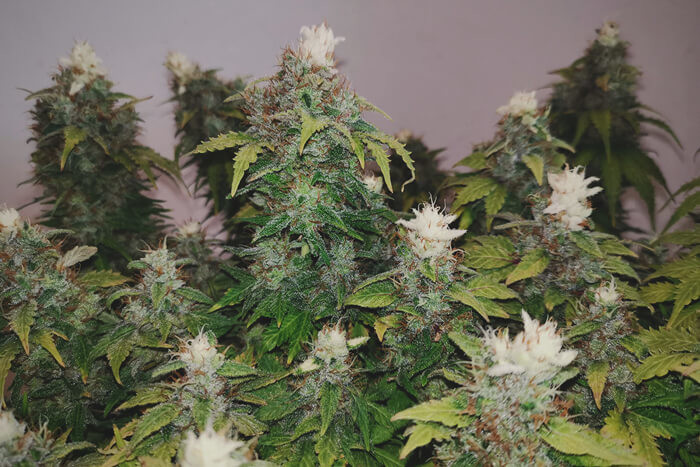
Find Out Why White-Tipped Buds Could Mean More Trichomes
Stepping into your grow room or garden and seeing white buds might dishearten you. However, if the conditions are right, you might have just boosted trichome production.
Contents:
How would you feel if you entered your grow room one morning and noticed that most of your colas had turned bright white? Would you be worried and concerned about the health of your plants? Or would you see it as a cause for celebration?
Here at Royal Queen Seeds, we often become elated when our customers send us pictures of their white-tipped buds. Of course, some cultivators ask us whether they should take immediate action to remedy this perceived issue.
That question isn’t totally strange, though. When thinking of health cannabis plants, most of us picture large and luscious fan leaves, thick health stems, and dark green or purple buds with spatters or trichomes and pistils. Considering that, seeing bright white tips form often raises the alarm. White tips have several causes. Sometimes the phenomenon indicates huge levels of desirable phytochemicals such as cannabinoids and terpenes. In other instances, white flowers are a sign of stress and damage.
Continue reading to discover the multiple root causes of white tips, when to celebrate, and when to take action.
White Tips May Possess Higher Levels of Trichomes
The emergence of white-tipped cannabis flowers appears to be a fairly recent phenomenon. Growers all over the world have cultivated the herb for decades without white tips being mentioned, and landrace strains seldom carry this trait.
So, why have bright white tips suddenly started popping up over the last few years? The answer seems to lie in new growing technologies that have managed to unlock this botanical trait. Although numerous growers have reported white tips, the occurrence started to enter the mainstream when a grower, photographer, and scientist joined forces to get to the bottom of it.
The Curious Story of Susan Gress
As a veteran cannabis cultivator, Susan Gress knew exactly what healthy and vibrant cannabis buds looked like. Typically, colas feature a bulbous bottom and a tapered top. They also feature dark green or purple tissue contrasted by evenly spread crystalline trichomes, and dark orange pistils. After bringing a routine cannabis crop into the late flowering stage, Gress noticed a strange happening that made her question the health of her crop—the tips of her colors were turning a brilliant white.
Baffled, Gress sought counsel from two experts for an explanation as to what could be causing the unusual aesthetic display. She called in her friend and photographer Bob Montoya to take a closer look. Armed with a powerful macro lens and professional camera, he snapped some close up images of the white tips.
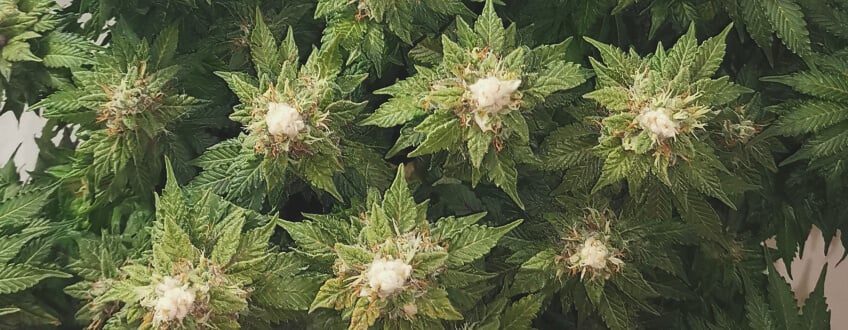
After reviewing the pictures, Montoya noticed that—despite their bright white appearance—both the buds and the plants as a whole looked healthy. He simply informed Gress that the color seemed to be a result of a massive productive of trichomes—which stirred plenty of excitement!
Before settling for such a positive outcome, Gress decided to get a second opinion. Who better to analyze the specimens, she thought, than neurologist and cannabis expert Dr Ethan Russo? Russo has published groundbreaking literature in the field of cannabis science, including works that broke down all of the major constituents of the cannabis plant[1] and changed the face of strain classification[2].
After inspecting the flowers, Russo reached a similar conclusion—the plants looked completely healthy. The odd aesthetics seemed to be a result of sky-high trichome production. These findings motivated Gress to bring a sample of the buds to a testing facility. The results showed significant concentrations of phytochemicals such as THC and terpenes, further evidence that trichomes were the cause.
What are Trichomes?
Why would a huge surge in trichome production be such a big deal? Well, trichomes underpin the cannabis experience. These structures churn out cannabinoids, like THC, and determine the potency and effects of cannabis strains. If researchers identify the mechanism behind increased production, it could change cannabis growing methods forever.
You’re probably familiar with the small crystal-like dots visible on the surface of cannabis flowers. These are the trichomes—small mushroom-shaped glands that exude a viscous resin. This substance contains a vast array of interesting chemicals, including cannabinoids and terpenes. In nature, these substances help plants to protect themselves against insects and extreme temperatures. For us humans, they serve as the source of chemicals that underpin enjoyable recreational highs and relief.
The more trichomes a flower possesses, the more resin it would exude and the more potent it will be—precisely why “sticky” flowers have gained a reputation in the world of cannabis.
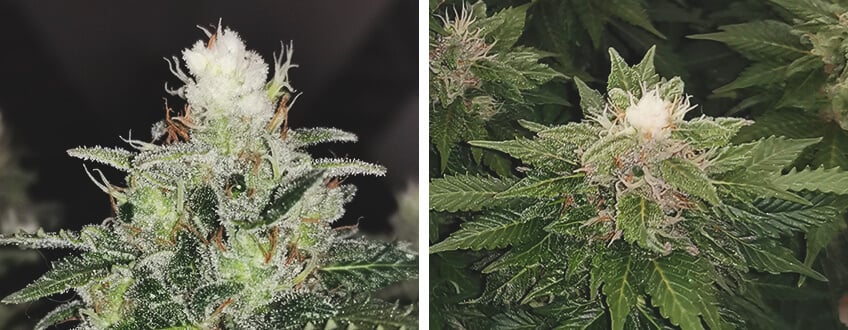
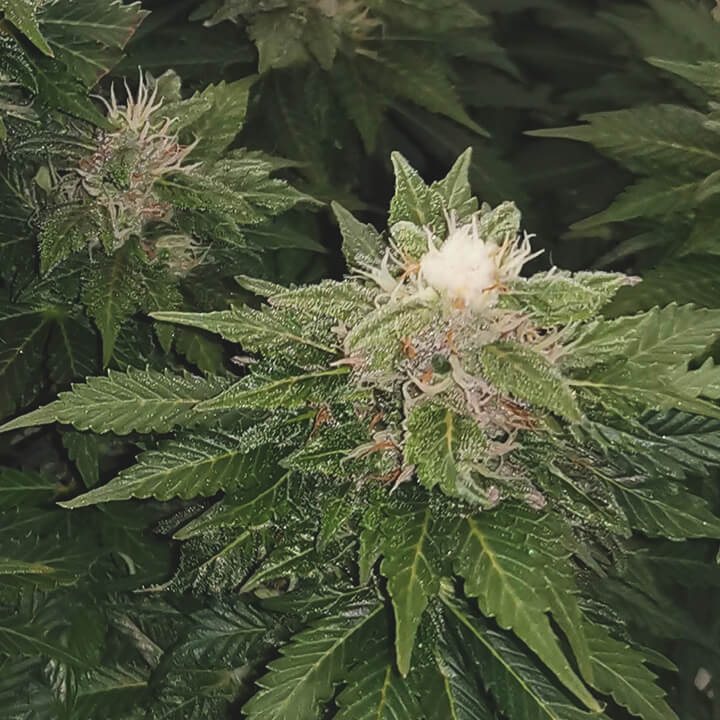
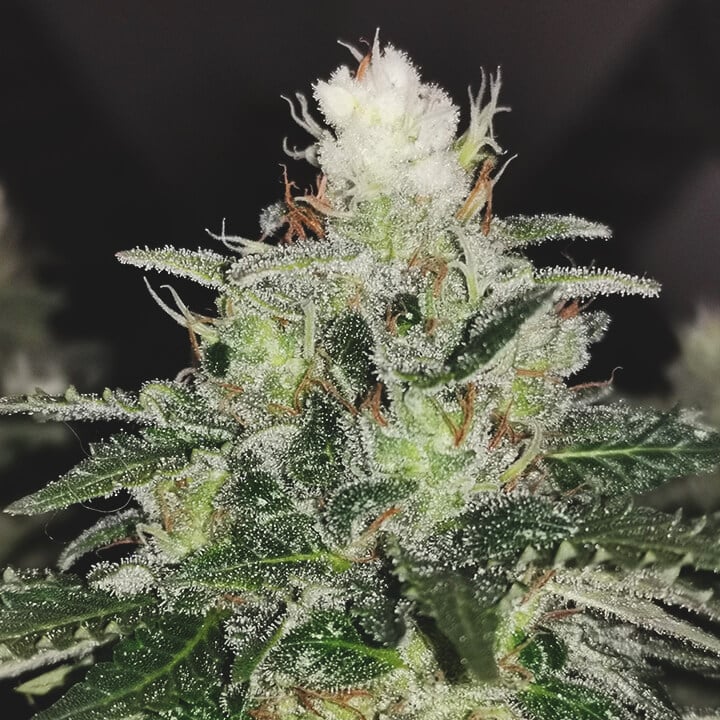
What Causes Enhanced Trichome Production?
Are white-tipped flowers the result of rare and freaky genetic mutations? Or can environmentally factors be tweaked in order to increase the probability of development? Gress believes her white colas are the result of LED lighting.
LED lights are a relatively modern development in the world of cannabis cultivation. These light sources utilise specific spectrums of light aimed and optimising cannabis growth. Gress came to the conclusion that her new LED set up triggered white tips to form, and other growers that experience white tips report the same.
LED lights also offer a range of additional benefits, including:
- Low heat
- More efficient to run
- Less stretching and more structurally sound plants
White Tips vs Heat Stress & Bleaching
Remember, whites tips aren’t always a sight to behold. Sometimes, they can indicate stress and damage. If colas are left to grow too close to a light source, they’ll be exposed to uncomfortable levels of heat. This can literally “burn” the tips and result in a white discoloration.
However, growers can easily differentiate heat-stressed buds from trichome-heavy tips. These flowers have a wilted look and will sit among yellow and curled sugar leaves and fan leaves. In contrast, buds with white tips maintain a healthy appearance and dark green foliage.
Although burned plants look dissimilar to true white-tipped specimens, bleached buds look much more alike. Bleaching also occurs due to heat stress, but flowers look much more healthy at first glance. Bleached buds also possess bright white tips, but not because of increased trichome production. Rather, the actual tissue of the flower turns bright white.
Bleached flowers take on their appearance due to physical damage, which also decreases terpene and trichome production. True white-tipped flowers still develop their unique color when positioned a safe distance from a light source.
White Tips vs Albino Plants
Just like some animals and humans, also cannabis plants exhibit albinism. This trait rarely shows up, but when it does, it creates an absolutely beautiful sight in the grow room and garden. This stunning color stems from a lack of the chlorophyll pigmentation that gives cannabis plants their green color. Albinism results from a genetic mutation, whereas white-tipped buds emerged due to environmental factors.
You Should Be Excited About White Tips!
Do you have white tips developing in your grow room? Some growers would be jealous! After ruling about light stress, albinism, and bleaching, you should be proud of your achievement! If your plants are positioned at a safe distance from good-quality LED lights, chances are you’re in for a cannabinoid-rich treat!
- Cannabis Pharmacology: The Usual Suspects and a Few Promising Leads - PubMed https://pubmed.ncbi.nlm.nih.gov
- The Cannabis sativa Versus Cannabis indica Debate: An Interview with Ethan Russo, MD https://www.ncbi.nlm.nih.gov
































